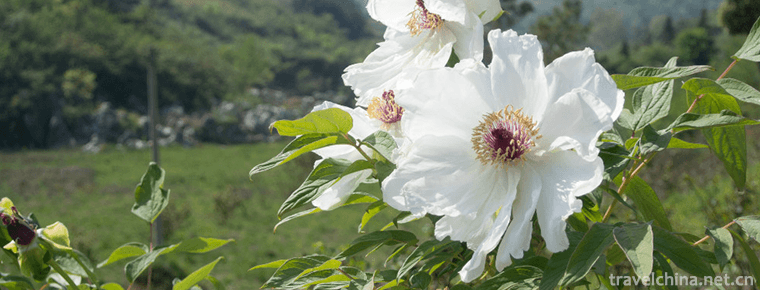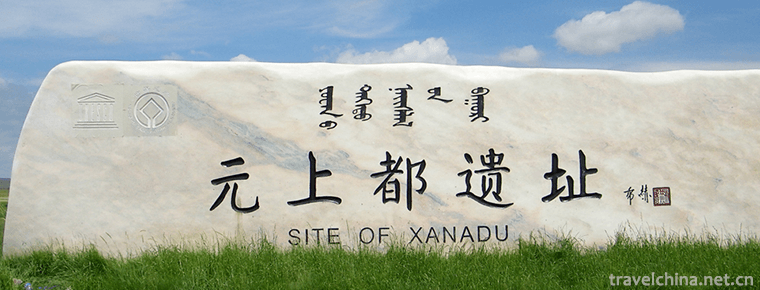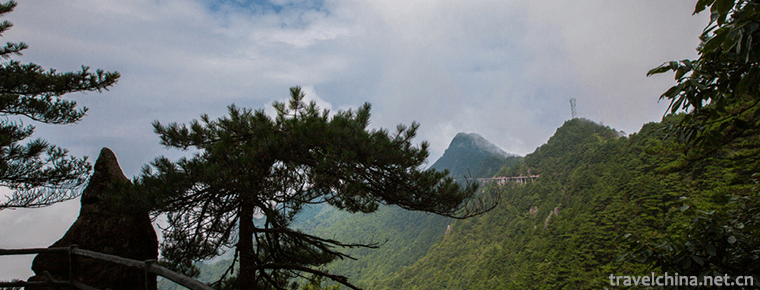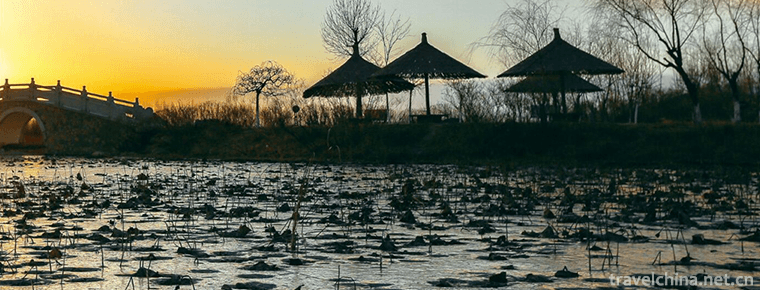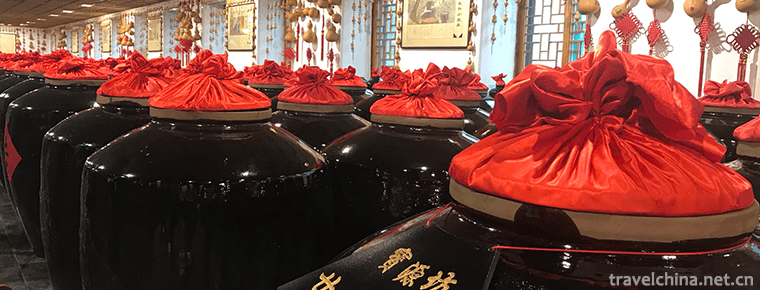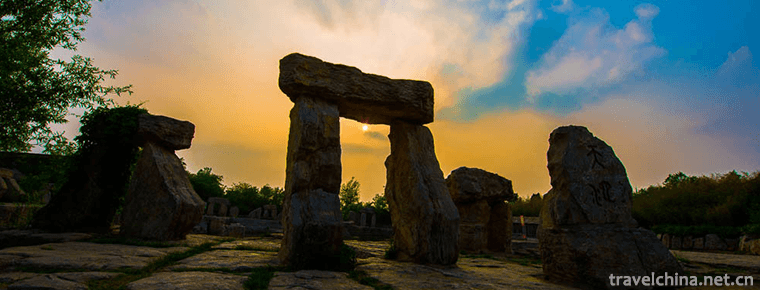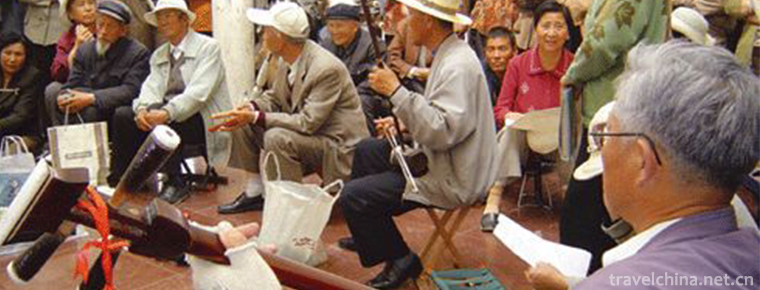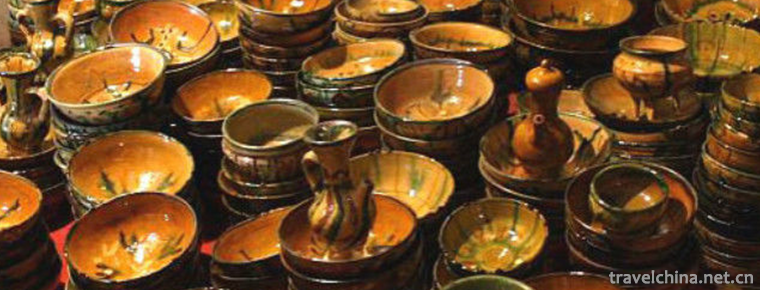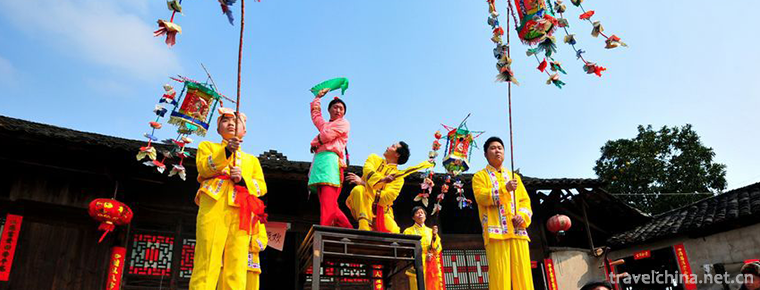Bangkok in Puzhou
Bangkok in Puzhou
Bangzi Puzhou, a local traditional drama in Linfen and Yuncheng, Shanxi Province, is one of the national intangible cultural heritage.
Bangzi of Puzhou is named for its origin in ancient Puzhou. Jinzhong and Northern Shanxi are called "Bangzi on the South Road" or "Bangzi Opera on the South Road", Shangdang is called "Xifu Opera", Henan is called "Xixi Opera", and Shanxi is called "Jin Opera", "Pu Opera", "Shanxi Bangzi" and "Bangzi Opera" in the northwest of Shaanxi Province and Gansu Province. Puzhou Bangzi has a high-pitched voice and is good at expressing generous and solemn historical stories. Music and performing arts have a deep tradition, especially in cap wings, feathers and hair shaking.
In May 2006, Bangzi Puzhou was listed in the first batch of national intangible cultural heritage list of traditional drama category, project number IV-19.
historical origin
Around the end of Ming Dynasty and the beginning of Qing Dynasty, a kind of local opera was formed and popular in Puzhou (now Yongji) of Shanxi Province, Tongzhou (now Dali) of Shaanxi Province, and in the Yellow River Delta of Shanzhou (now Shaanxi County) of Henan Province. At first people called it "random play" or "local opera", and because of the jujube wood as bang, Festival singing, so it is also known as "Bang Ziqiang". From Kangxi to Qianlong and Daoguang dynasties, there are many records about the performance activities of the professional theatre troupes in Baishan Temple of Puxian County.
Kangxi forty-seven years (17080 Kong Shang Ren in his "Pingyang Bamboo Branch Ci" has a description: "Random play Zeng Bocuihua see, it is difficult not to get a banquet letter, favorite Kwai Wa stroll, Shumian is handan."
After Jiaqing and Daoguang, the random bombs in Puzhou area were gradually divided into two groups: South Road and West Road. Ruicheng is the center of Nanlu Opera. Its main repertoires are eight, eight and eight, totaling 24. Most of them are transplanted from Kunqu Opera, such as Hongmei Pavilion and Fifteen-Seven-Session Opera. The characteristics of Nanlu Opera are fewer lyrics, more four or six sentences constitute a aria, with elegant language and exquisite plot. The singing performance is also more elegant. Male actors don't need fake voice to sing. The singing is multi-step and less big jump. Puzhou (now Yongji) is the center of Xilu Opera, and Pingyang (now Linfen) belongs to it. It has rich repertoire, more lyrics, and a large number of singing tunes. Its lyrics are popular and popular. Its performances are fierce, and the use of duet, performance and special skills.
By the time of the War of Resistance Against Japan, the Southern Road Opera gradually merged with the Western Road Opera. From the end of the Qing Dynasty to the beginning of the Republic of China, Bangzi Opera has become an indispensable part of worship to gods, celebrating birthday ceremonies and fairs in Puzhou and Pingyang. Between Tongzhi in Qing Dynasty and Guangxu to the Republic of China, Bangzi troupes grew to more than 40. In the seventh year of Guangxu (1881), the Hewen Temple founded by Qi Yanzi and Guo Baochen participated in 16 subsidized classes. During this period, Bangzi in Puzhou continued to go out to perform. Wang Lai performed directly to Beijing along the lines of Jinzhong, Jinbei, Datong, Zhangjiakou and Xuanhua; Qi Yanzi's performance to the North stirred Zhangjiakou; Yang Dengyun led his class to Laohekou, Hubei, and Xi'an, Shaanxi; Zhang Weiwa, Wanquan County (now Wanrong County), led the "Quansheng Class" to Jiuquan, Gansu. Since then, Yang Wa has also been active outside the mouth with "Quansheng Class 2" to Dunhuang, Turpan, Urumqi and other places. In addition, Class 8, Class 60, Class 8 sticks, Class Hesban and Class 4 children are all representative classes with strong strength. During this period, many well-known actors appeared in Puzhou and Pingyang areas, such as Lao Qisheng, Lao Yuanhong (Zhang Shixi), Lao Sanzhang (Wang Lailai), Yanzihong (Qi Yanzi), Baicaixin (Yun Sanji) and Babaihei (Lu). Changlin, Living Yanzi (Ren Xiangwa), Tangerhong (Li Yantang), Xushengjing Hengchun, Peng Fukui, Cao Fuhai, Xiaodan Feng Sangou, Sun Guangsheng, Wang Cuncai, Zhengdan Feng Anrong, Yao Miaohong (Song Youmei), Xuelimei (Zhang Jinbang) and so on.
During the Anti-Japanese War, artists dispersed everywhere. Some fled to the northwest and organized "Tang Feng Society", "Jin Feng Society" and "Yu Feng Society" in Xi'an. In Pingliang, Lanzhou and Suiyuan, there were "Pingliang Jinsheng Society", "Jinsheng Society" and "Tangsheng Amateur Opera Society". In the other part, there are the first, second and fifth teams of cultural propaganda of the commander's headquarters of the Second War Zone in Luliang Mountain, the Pu Opera Troupe of the Southern District Cooperative in Yan'an, the Jiefang Opera Troupe of the Taiyue Anti-Japanese Base, the Pu Opera Troupe of the Taiyue Middle School and so on. In addition to performing traditional operas, most of these performing groups have performed many new historical plays and modern operas in line with current events.
Distribution area
Bangzi in Puzhou (now in Yongji County, Shanxi Province), also known as Bangzi in Puzhou, also known as "random bullet", "Jin cavity", "Shan-Shan Bangzi cavity", and so on. Bangzi in Puzhou and Bangzi in Middle Road, Bangzi in North Road and Bangzi in Shangdang are also known as the four Bangzi in Shanxi Province. It distributes in the south of Shanxi and parts of Shaanxi, Henan, Gansu and Qinghai provinces.
Puzhou Bangzi was originally a Hedong School of Shan-Shan Bangzi. Shaanxi Bangzi was formed in the triangle of Puzhou, Shanxi Province, Tongzhou (now Dali County of Shaanxi Province) and Shaanzhou of Henan Province (now Shaanxi Province) in the late Ming and early Qing Dynasties. The Hedong School originally spread to Qinshui in the east, the Yellow River in the west, Hanxinling in the north and Shaanzhou in the south.
Inheritance and Protection
Protective value
In the system of Bangzi Opera, Bangzi in Puzhou is the earliest one of the four Bangzi in Shanxi Province. It has a relationship with Bangzi in Shaanxi Province. It is a living material for investigating the trajectory of the inheritance and evolution of Chinese local opera, and also plays an important role in Shanxi local culture research.
Current situation of inheritance
Under the impact of the commercial tide, Bangzi in Puzhou is in crisis, audiences are losing a large number, and the cast is green and yellow.
Heritage figures
Zhang Feng, male, Han nationality, born in 1925, Linyi, Shanxi Province. In June 2008, Zhang Feng was selected as the representative successor of the second batch of national intangible cultural heritage projects and declared by Linfen City, Shanxi Province. Declaration items: Bangzi Puzhou.
Ren Hexin, female, Han nationality, born in 1963, Xiangfen, Shanxi Province. In June 2008, Ren Jixin was selected as the representative successor of the second batch of state-level intangible cultural heritage projects and declared by Linfen City, Shanxi Province. Declaration items: Bangzi Puzhou.
Guo Zemin, male, Han, born in 1960 in Yaodu, Shanxi Province. In June 2008, Guo Zemin was selected as the representative successor of the second batch of national intangible cultural heritage projects and declared by Linfen City, Shanxi Province. Declaration items: Bangzi Puzhou.
Wu Junying, female, Han nationality, born in 1956, is a native of Xinjiang, Shanxi Province. In June 2008, Wu Junying was selected as the representative successor of the second batch of national intangible cultural heritage projects. Yuncheng City, Shanxi Province declared. Declaration items: Bangzi Puzhou.
Wang Xiulan, female, Han nationality, born in 1932 in Shuozhou, Shanxi Province. In June 2008, Wang Xiulan was selected as the representative successor of the second batch of national intangible cultural heritage projects and declared by Yuncheng City, Shanxi Province. Declaration items: Bangzi Puzhou.
protective measures
After the founding of New China, the cultural authorities of the People's Government strengthened their organizational leadership and artistic construction of Pu Opera societies, organized key opera troupes, equipped with professional backbone, excavated, identified and processed traditional operas, and carried out bold reforms in performance, music and singing.
In August 2018, the National Art Fund funded project "Pu Opera Performing Talents Training" was sponsored by Yuncheng Pu Opera Troupe. Drama experts from Yuncheng Culture and Art School and Yuncheng Drama Research Institute were invited to form a teaching team to strengthen the training of students. After class teaching, Shipu will also organize students to go out to watch performances and study.
From July to September 2018, Pu Opera "Mother of Mountain Village" Youth Performing Talents Training Project was organized and implemented by Yuncheng Pu Opera Youth Experimental Group. With the core idea of "cultivating outstanding young talents, inheriting and developing Pu Opera undertakings", senior experts and teachers in theatre circles were invited to concentrate on teaching and teaching for the students.
social influence
Honorary recognition
In 1983, Ren Hexin and Guo Zemin, the new comedians of Pu Opera, won the first national "Plum Blossom Award" for Pu Opera and won new honors for Pu Opera art. After that, Wu Junying, Cui Caicai, Lei Junsheng, Jing Xuefeng, Ji Youfang, Wang Yihua, Zhang Ju and so on, won many prizes in provincial capitals, and Wu Junying won the fifth "Plum Blossom Award" in China.
Performing activities
Pu Opera Troupe performed six times in Beijing in 1952, 1957, 1959, 1963, 1979 and 1983, and was praised by Party and state leaders, theatrical artists and audiences. At the same time, Pu Opera troupe also performed in Shaanxi, Henan, Gansu, Qinghai, Fujian, Shanghai, Sichuan, Hubei and other provinces and municipalities successively, which was well received by the audience.
In 1959, in commemoration of the 500th anniversary of Guan Hanqing's birth, Pu Opera actors Wang Xiulan, Yan Fengchun, Zhang Qingkui, Xiao Yuelai and Yang Hushan participated in the performance of "Dou E Yuan", which was produced by Changchun Film Studio and was praised by audiences all over the country after its screening.

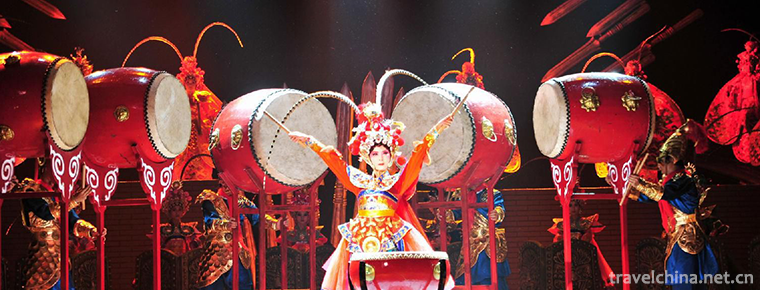
-
Yashan Huahai Stone Forest
Yashan Huahai Stone Forest Tourist Area, located in Nanling County, Wuhu City, Anhui Province, is one of the important scenic spots in Anhui's "two mountains and one lake" tourism economic c.
Views: 160 Time 2018-12-20 -
Ming Yue Mountain
Mingyue Mountain Tourist Area of Yichun City, Jiangxi Province, is located 15 kilometers southwest of Yichun Central City, with an area of 104 square kilometers. .
Views: 158 Time 2019-02-07 -
Mingcui Lake National Wetland Park
Yinchuan Mingcuihu National Wetland Park is located in Zhangzheng Town, Xingqing District, Yinchuan City, Ningxia. It is 9 kilometers away from Yinchuan City and 3 kilometers .
Views: 170 Time 2019-02-07 -
Taiyuan Qingxu Baoyuan Old Vinegar Workshop
Taiyuan Qingxu Baoyuan Old Vinegar Workshop is located in Taiyuan City, Shanxi Province. It is the "Taiyuan Youth Heritage and Education Base". It has been awarded the "First Industrial.
Views: 170 Time 2019-02-13 -
Wangcheng in heaven
Tianwangcheng Scenic Area is located 40 kilometers northwest of Yishui County, Linyi City, Shandong Province. The main part of the Scenic Area is located in Jiwanggu. It is the national AAAA scenic sp.
Views: 102 Time 2019-02-21 -
Ping Zhou He Zhou
Hezhou Pingxian was known as Pingdiao and Rhythm in ancient times, and it was also called Linxia Pingxian after 1949. Its main musical instrument is three strings..
Views: 239 Time 2019-05-03 -
She Nationality Medicine
She medicine is mainly distributed in Jingning She Autonomous County of Zhejiang Province and in some mountainous areas of Fujian and Jiangxi provinces. She nationality has no written language and is .
Views: 127 Time 2019-06-14 -
Uygur moulding earthenware firing
Uygur moulding pottery has a history of more than two thousand years. After the middle of the ninth century, Uygur ancestors moved westward to the vicinity of the Tarim Basin, inherited the pottery ma.
Views: 184 Time 2019-06-26 -
Xiushan Festive Lantern
Xiushan lantern is an important school of lantern art in southwest China. It is a folk cultural phenomenon and folk performing art that integrates religion, folk custom, singing and dancing, acrobatic.
Views: 80 Time 2019-07-08 -
Population of Mianyang
By the end of 2018, the total number of households in Mianyang was 2 million 61 thousand and 800, and the registered residence population was 5 million 362 thousand. At the end of the year, there were 4.857 million permanent residents, with the urbanization.
Views: 110 Time 2020-12-14 -
Leshan peoples life
By the end of 2018, the per capita disposable income of rural residents in Leshan City was 15173 yuan, an increase of 8.9%, and the per capita living consumption expenditure was 12309 yuan, an increase of 9.5%. The per capita disposable income of urban residents .
Views: 294 Time 2020-12-17
